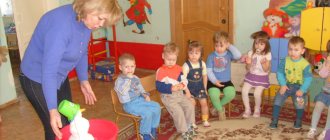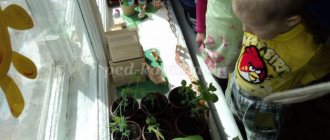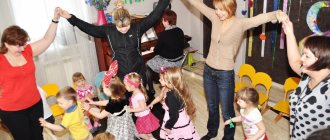MAGAZINE Preschooler.RF
Card index of games using TRIZ technology, first junior groupAuthor's development teacher: Tkachenko E.A.
1. Didactic game: “Relief sign and hand analyzer”
(Balls in relief)
Goal: To develop in children the ability to independently examine an object to determine the meaning of a sign. We determine the name of the feature using the hand analyzer.
Objectives: Development of children's cognitive abilities in the process of joint research activities;
Develop observation skills;
To introduce children of primary preschool age to the sign “relief” and its meanings;
Progress of the game:
Q: Guys, what sign is shown on the box?
D: Relief.
Q: Which smart head assistant will help us determine the topography of an object?
D: Hand.
Q: Look at the balls in the box.
Let's determine which ball is based on its relief?
D: (smooth), (prickly).
Q: Which smart head assistant helped us determine the relief of objects?
D: Hand.
Q: The hand touches, and the smart head sees and understands what kind of relief the ball is.
Thanks guys!
2. Didactic game: “Humidity sign and hand analyzer”
(handkerchief)
Goal: To develop in children the ability to independently examine an object to determine the meaning of a sign. We determine the name of the feature using the hand analyzer.
Objectives: Development of children's cognitive abilities in the process of joint research activities;
Develop observation skills;
To introduce children of primary preschool age to the sign “humidity” and its meanings;
Progress of the game:
Q: Guys, what sign is shown on the box?
D: Humidity.
Q: Which smart head assistant will help us determine the humidity of an object?
D: Hand.
Q: Look at the handkerchiefs in the box.
Let's determine which handkerchief by moisture content?
D: (dry), (wet, damp).
Q: Which smart head assistant helped us determine the humidity of objects?
D: Hand.
Q: The hand touches, and the smart head sees and understands the moisture level of the handkerchief.
Thanks guys!
3. Didactic game: “Color sign and eye analyzer”
(Masha and her plates)
Goal: To develop in children the ability to independently look to find out the meaning of a sign. We determine the name of the feature using the eye analyzer.
Objectives: Development of children's cognitive abilities in the process of joint research activities;
Develop observation skills;
To introduce children of primary preschool age to the sign “color” and its meanings;
Progress of the game:
Q: Guys, what sign is shown on the box?
D: Color.
Q: Which smart head assistant will help us determine the color of an object?
D: Eyes.
Q: Look at the multi-colored plates in the box.
Let's help Masha identify which plates by color?
D: (blue), (red), (green), (yellow).
Q: Which smart head assistant helped us determine the color of objects?
D: Eyes.
Q: The eyes look, but the smart head sees and understands the color of the plate.
Thanks guys!
4. Didactic game: “Color sign and eye analyzer”
(Flowers and butterflies)
Goal: To develop in children the ability to independently look to find out the meaning of a sign. We determine the name of the feature using the eye analyzer.
Objectives: Development of children's cognitive abilities in the process of joint research activities;
Develop observation skills;
To introduce children of primary preschool age to the sign “color” and its meanings;
Progress of the game:
Q: Guys, what sign is shown on the box?
D: Color.
Q: Which smart head assistant will help us determine the color of an object?
D: Eyes.
Q: Look in the envelope for multi-colored (four-color) flowers and butterflies of the same color. Let's help the butterflies find a flower by color.
D: (blue), (red), (green), (yellow).
Q: Which smart head assistant helped us determine the color of objects?
D: Eyes.
Q: The eyes look, but the smart head sees and understands the color of the butterfly and flower.
Thanks guys!
5. Didactic game: “Sign color and eye analyzer”
(Like a cockerel choosing its own color).
Goal: To develop in children the ability to independently look to find out the meaning of a sign. We determine the name of the feature using the eye analyzer.
Objectives: To clarify children’s knowledge about colors: red, yellow, green, blue. Encourage children to fantasize based on changing the values of the “Color” .
Progress of the game:
Q: Guys, what sign is shown on the box?
D: Color.
Q: Which smart head assistant will help us determine the color of an object?
D: Eyes.
Q: The Cockerel (colorless silhouette) came to visit us.
D: The children greet him and get to know him.
Q: He notes that the Cockerel is white and asks the children how to make him beautiful (listens to all the options without comments).
I suggest you send Cockerel for a walk along the “magic path” .
D: Children name the colors that live on this path.
Q: The cockerel walks along the path and is painted in the appropriate color.
The Cockerel asks the children to bring toys of the appropriate color, name the toy and its color. The teacher generalizes that all toys are red.
The cockerel asks the children to find the color red in the children's clothes.
Q: Which smart head assistant helped us determine the color of objects?
D: Eyes.
Q: The eyes look, but the smart head sees and understands the color of objects (cockerel, path, toys).
At the end of the lesson, the cockerel thanks the children for making him beautiful, elegant, and colorful.
| Next > |
Integrated lesson for children of the second junior group using TRIZ technology
Transcript
1 Integrated lesson for children of the second younger group using TRIZ technology Topic: “Journey to the fairy tale Kolobok” Performed by: Mironova A.V.
2 “Journey to the fairy tale Kolobok” Objectives: To create conditions for the development of children’s ability to answer the teacher’s questions; consolidate knowledge of fairy tales. Objectives: 1. Develop cognitive activity, attention, memory, creative capabilities using elements of TRIZ technology. 2. Activate children's vocabulary with the help of familiar fairy tales and fairy-tale characters. 3. Foster curiosity and friendliness; evoke positive emotions. Materials: ball, “Magic chest”, it contains a bun, a hare, a fox, sheets of paper (with balloons pre-drawn in wax, brushes, paints. Preliminary work: reading fairy tales, speech games to select adjectives for nouns, solving problem situations Progress of the lesson (Children enter the group, stand in a circle, hold hands) Educator: Guys, today we are going to go to a fairy tale. And guess which one 1. Here is flour, and here is sour cream. I’m going to make a bun. I’ll roll up my sleeves, make the dough quickly I'll knead it. I'll put it on the window so that it cools a little. 2. But first, I want to know how well you know fairy tales? (the teacher throws the ball to the children, asks questions) - Who ate the kids? - Who came to visit the bears? - B What fairy tale did the grandfather beat and beat an egg and did not break it? - That the “Big Big” grew up? - What happened to the ice hut?
3 - Who left grandma and left grandfather? (Brainstorming method) Educator: Well done guys, you know fairy tales well. Now you and I can hit the road. —What can you go on a trip with? (train, plane, car). Let's all get on the train and go to a fairy tale. - Look, guys, a fabulous magic chest. - Let's see what lies there (the teacher looks into the chest). -Here are objects from fairy tales. Guess the riddle: They scraped the bottom of the barrel, swept the barn, and rolled through the forest without roads (takes out a bun) - What kind of bun? (round, ruddy, naughty). -What else is round? (method of analysis) (ball, ball, apple, sun, watermelon) - What happened to the kolobok? (children's answers). - How would you save the bun? (trial and error method) 3. Guess another riddle: Long ear Jumps deftly Loves carrots (The teacher takes a bunny out of the chest) Game “Where does the hare live?” (in the forest, in the zoo, in books, in cartoons)
4 4. Physical education The gray bunny washes his face. Apparently, he is going to visit, (the children are “washing themselves.”) I washed my nose, washed my tail, washed my ear. (children rub their nose, tail, ears with their palms.) Wipe it dry! And he galloped off. Jump jump! Jump jump! (children jump, sit on chairs) 5. Riddle: Cunning cheat, red head, fluffy tail - beauty! And her name is. (The teacher takes out a fox from the chest) Game “Good - Bad” Educator: A fox is good. Why? Children: Because she is beautiful, fluffy, soft, red-haired Educator: A fox is bad. Why? Children: Because he steals chickens and geese, eats mice and hares Educator: You and I saved the bun from the fox. But the fox became sad. - Do you want the fox to become joyful and cheerful again? To do this, you and I will turn into little wizards. And these magic brushes and sheets of paper will help us with this. You need to paint these sheets with paint and you will see what happens. 6. Finger gymnastics I kolobok, kolobok (“roll” on the palm) Scrape the bottom of the barrel (scratch the left hand with the right hand) Sweep across the barn (imitate sweeping0 On sour cream meshen (make circular movements with the right hand) Sazhen in the stove (show two arms outstretched forward)
5 It’s cold on the window (they show “window” with both hands) I left my grandmother, and I left my grandfather (the index and middle fingers of the right hand run along the palm of the left) 7. Art activities (Children begin to work. An image of balloons appears on the sheet ) -What did you get? What types of balls are there? (red, blue, large, small, round, oval) (Children give the fox their works. The fox is joyful. Thanks the children. Runs away into a fairy tale). Result: What fairy tale were we in? Next time we will go to a different fairy tale. What fairy tale would you like to be in?


